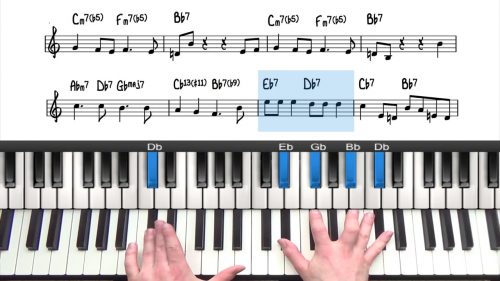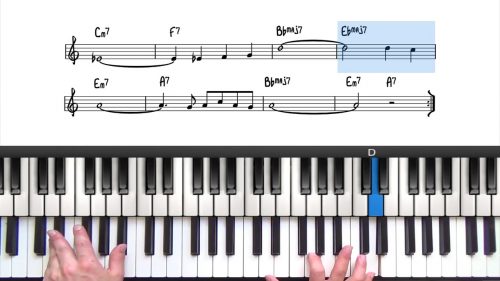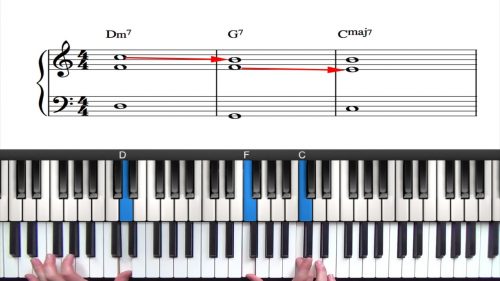Coltrane Changes: Major Third Tonic Relationship
In this 5 minute masterclass, we’re going talk about the infamous Coltrane Changes.
Coltrane changes, also known as the ‘Major Third Tonic relationship’ is a harmonic movement where instead of one tonic center, we have 3, which divide the octave into 3 equal parts, for example in the key of C, the other tonic centres would Ab, and E.
The ‘Major Third Tonic relationship’ can also be found in classical music, but in this masterclass, we’re just going to focus on jazz repertoire.
Examples Before Coltrane – “Have You Met Miss Jones”
The ‘Major Third Tonic’ chord progression was used before Coltrane. For example, this exact progression can be found in the Rodgers and Hart song “Have You Met Miss Jones” which may have been an inspiration for Coltrane and others who wrote music using the Major third relationship.
John Coltrane’s “Giant Steps”
The tune “Giant Steps” can found on Coltrane’s album by the same name. The whole Giant Steps Album is definitely worth checking out.
The tune “Giant Steps” is probably the most well-known song composed around the ‘Major Third Tonic’ Relationship. The tonal centers are B, G, and Eb. The song moves faster through the changes in the first 8 bars and slower in the next 8.
Even if Giant Steps is very hard to improvise over, the harmonic structure is seemingly simple; It’s just dominants leading to the tonics.
John Coltrane’s “Countdown”
Coltrane’s composition “Countdown” is another tune which incorporates the Major Third Tonic Relationship. Again this record first appeared on Coltrane’s iconic album “Giant Steps”.
“Countdown” is based on Eddie Vinson composition “Tune Up” which we covered in the course on “Jazz Piano Foundations” – check out the related lesson section below for more information.
As we demonstrate, Coltrane took 4 bar long 251 progressions, and reharmonizes it by adding in the other Tonal centers, then approaching them with their related dominant V7 chords.
Lesson Downloads
-
“Coltrane Changes” Notation File Type: pdf
Practice Tips
-
To improve your understanding of Coltrane Changes, go and listen of course the album "Giant Steps"
-
Also, check out the album "Coltrane Sound" where he uses the reharmonization over several different songs.
-
"26-2" is based on "Confirmation", and "Satellite" is based on "How High the Moon" - just two name two.
-
At the end of this lesson, we demonstrate how to apply the Coltrane Changes to a 251 Progression in F.
-
As an exercise, pick any 251 and work out the Coltrane Changes based on the Major Third Tonic Relationship.
-
Take this around all 12 keys to familiarise yourself with this fascinating reharmonisation.






Hi Hayden, I am unable to download the ” Coltrane Changes ” worksheet, I get a message saying Failed – Forbidden 🙁
Hi Natasha,
Apologies for this… i will email you the download now.
I am aware of this issue…. We are currently upgrading our course system and there is a few temporary glitches like this. It will be resolved shortly.
You can also try switching browsers which I have been told fixes it. Google Chrome was problematic for one student.
Again my apologies and it will be fixed very soon.
Look out for my email too 🙂
Hayden
Hello Hayden I really didn’t understand the explanation of the 251 Coultrane changes. Im having trouble picking the target note for the 1 in the 251. I understand the Em to A7 to Dmaj7 (251). Could you further explain the Em7 F7 to Bbmaj7 to Db7 Etc how is the being used. I was thinking tritone at first but not sure or should I look at this as Em then 5 1. this is where I start to confuse myself. lol. Can you please clarify for me
thanks in advance first post in a long while
Hi Samuel, thanks for writing!
This is a valid question. When it comes to the Em7 F7 to Bbmaj7, you should think of the Em7 as just a replacement chord for Dmaj, Coltrane took little artistic liberty there 🙂
The whole Coltrane chain would be Dmaj7 – F7 -> Bbmaj7 – Db7 -> Gbmaj7 – A7 -> Dmaj7
Here you just have plain V I cadences in 3 different tonal centers, D, Bb and Gb (see the arrows).
To explain how to apply this to other situations, you simply apply this over the 251 cadence, check out the last part of the video, starting on 5:22.
I hope this helped, let me now if you have any further questions!
-Tuomo
T
Sorry – these changes are not “Explained” – you play them, which I can do from any lede sheet. I may be too critical here, but there’s no real “explanation” about the changes. This is not a Master Class – can you do this again please in a little more detail? Hayden generally steps through the chords so they make more sense. We’re all trying to learn here, not just watch someone play cool stuff.
Hi Harry,
Thanks for your comments and yes we can certainly cover this topic in more detail.
These 5 minute masterclasses are designed to be a quick introduction or summary of a topic or theory area, and I agree with you that this particular topic would be more suited to a different, lengthier format.
I will chat with Tuomo about covering this topic in an upcoming live seminar which would give him a full hour to cover the underlying theory, show examples, and explain the harmonic relationships.
I am about to set our upcoming live seminar topics for April and so it’s good timing. I will send you an email once I have worked out a plan with Tuomo.
Cheers, Hayden
Thanks so much for your quick reply.
My pleasure Harry.
I spoke with Tuomo and he will be covering this topic for his live seminar in April.
The email for April’s seminar agenda will be sent to all students around the end of the month.
Cheers and stay safe! Hayden
Hi Harry,
Thank you for writing,
and thank you for feedback, very much appreciated! Student’s feedback and suggestions are more than welcomed, this way we can improve the material and make the learning experience more fluent and thorough.
Stay tuned for the live seminar,
Until then, let me know if you have any questions on the topic (or any other subject), or if I can help anyhow!
-Tuomo